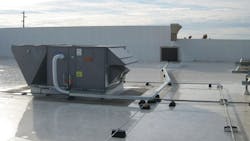Distributed Energy at the Speed of Ice
To improve system efficiency while keeping California’s tougher regulations in mind, the city of Redding’s electric authority, Redding Electric Utility (REU), began looking at alternative methods in 2004 for gaining higher efficiency from its existing distribution assets without having to install additional capacity. Today, REU has an installed generation capacity of 160 MW to 180 MW and a peak demand of 250 MW.
REU identified a then-new thermal energy storage (TES) technology developed by Ice Energy Holdings Inc. from an online search in 2004. Although TES was a fairly mature concept, Ice Energy’s unique control methodology made it far more practical and cost-effective for managing peak loads.
For REU, the TES solution offered an attractive turnkey option for managing the peak load. The utility began pilot projects on a small scale later that year.
Ice Energy Storage Units
TES units work in tandem with commercial air conditioning (AC) systems during peak load cycles, typically from noon to 6 p.m. In discharge mode, condensers are switched off and environmentally friendly R-410a refrigerant, chilled by the storage unit’s melting ice, is pushed by a high-efficiency pump to a special coil installed in the existing AC system. In this discharge mode, the pump consumes a mere fraction of the power used by a high-efficiency condenser, up to 95% less.
Ice Energy manufactures an ice energy storage unit that can create up to six hours of cooling at peak hours by freezing 450 gal (1,703 l) of water overnight when the electricity demand and energy tariffs are low. The cooling capability of the Ice Bear Energy Storage unit is stored in the form of ice in an insulated tank and uses the melting ice to cool a building, thereby displacing the AC’s condensing units during peak ambient temperature periods.
REU launched two pilot projects by retrofitting Ice Bear TES units at local businesses to evaluate their long-term performance over consecutive summers. Test results were promising as they confirmed the technology could cost-effectively serve the utility’s long-term reliability requirements and peak energy price investment objectives.
Program Acceleration
REU opted to accelerate its energy storage acquisition program in 2007 when it purchased 10 TES units and an additional 50 units in 2008. Each unit remains an REU-owned asset, installed and maintained on customer properties and buildings at no cost to the customer.
In one of Redding’s program applications, the energy storage system was designed into a new construction project. The commercial developer, The Imperial Group, teamed with REU, local architects, Ice Energy and AC manufacturer Trane for the construction of a single-story 21,000-sq ft (1,950-sq m) office building. In addition to installing 11 high-efficiency rooftop AC units and TES units, the building features white heat-reflecting roofing and 12-inch (30-cm)-thick insulated concrete for maximum energy efficiency.
Following a year of trial and monitoring, this building project produced outstanding performance statistics. The AC-TES combination was able to reduce the building’s on-peak demand by 107 kW and shift 23.3 MWh of peak energy to the off-peak period while recording 98.9% reliability over a 12-month period. TES provided better on-peak cooling performance than standard AC without requiring customers to sacrifice or change behavior patterns. The daily AC load reduction allowed REU to reduce costly peak energy deliveries, helping to maintain the lowest cost of service to customers.
The Ice Bear controller acts as the master and is connected wirelessly to AT&T’s advanced two-way network architecture. Back-office remote monitoring and control systems are hosted by RackSpace, a secured data center service provider. Each storage unit can be remotely configured to operate in alignment with substation and distribution feeder circuits to avoid grid constraints caused by summer peak load requirements.
Using Ice Energy’s CoolData web portal graphical interface, utility operators can monitor storage, and heating, ventilation and air conditioning (HVAC) performance as well as schedule and dispatch Ice Bear operations, similar to starting and stopping generation resources. In addition, distributed thermal storage can increase the value of renewable resources that often produce energy during nonpeak periods. By storing renewable energy, utilities can increase the value of green resources by moving their energy production during periods of the day when energy is more valuable. California Energy Commission studies conclude that shifting energy usage from day to night can deliver up to 30% source fuel savings for utilities.
Cumulative Benefits
As a result of the excellent performance of REU’s pilot projects, Ice Energy was keen to develop the proven technology further by inviting REU to consider a turnkey megawatt-scale-capacity purchase. The technology had been successful and the question simply became how to scale the project upward. In 2010, REU received authorization from the Redding City Council to invest in a 0.5-MW capacity purchase of Ice Bear units and launch a citywide study to evaluate the megawatt potential for TES within its boundaries.
Ice Energy successfully secured REU customer participants, and designed, installed and commissioned 0.5 MW of distributed TES systems, demonstrating its capabilities to deliver on time and on budget. In parallel to the deployment and in coordination with REU, Ice Energy initiated a four-month study that collected AC load data from 4,500 local commercial and industrial businesses throughout REU’s service territory.
The survey results showed nearly one-third (70 MW) of Redding’s 250-MW total peak load was driven by commercial AC. The new data and recent experience were sufficient for Redding to confirm a larger megawatt-scale TES program was feasible. REU was skeptical at first, but it was not long before Ice Energy and local contractors were deploying Ice Bear TES assets in megawatt-scale units that significantly reduced the impact of the increased workload on the utility staff.
The Ice Bear units are being installed in existing buildings, so it is the rating of the installed AC system that determines the rating of the Ice Bear installed. In general, the reduction in energy demand averages between 10 kW to 15 kW per installation. At present, because of the existing tariff structure, the customer benefits are limited to improved cooling and an increased life expectancy of the AC system, as the existing AC compressors are nonoperational during the six-hour period of high ambient temperatures.
Soon after the 0.5-MW program was underway and demonstrating capacity reduction, REU began comparing the cost-effectiveness of energy storage against traditional resource options and developed a long-term megawatt-scale deployment plan. To date, REU has installed 153 TES units in local commercial and industrial businesses, equivalent to 2.22 MW of peak capacity.
REU’s long-term energy storage plan is to counter the utility’s annual peak load growth with the peak reduction attributable to the installation of Ice Bear units. This will support REU’s strategy to reduce its peak power procurements and future need to construct new generation resources to meet peak and spinning reserve capacity requirements. In June 2012, the Redding City Council approved a second phase of a utility-scale TES program to install 6 MW over a five-year term.
Investment in the Community
REU considered the project expansion as a practical way to not only address its energy future but direct utility peak capacity investments into the local economy. The appeal for energy storage was to keep peak resource procurement dollars local versus spending this money for assets that would send investment dollars outside the community.
Ice Energy relies on Redding’s local businesses to support project design, construction and ongoing equipment maintenance services. Project materials and supplies are procured locally, creating local business and job opportunities. Throughout the year, Ice Energy has 14 local businesses supporting the project and will do so for the remaining contract term.
In addition to job creation, the program has several other deep, lasting benefits for the Redding community. For example, a restaurant included in an early TES pilot project now benefits from improved cooling in its kitchen during the humid summer months, enhancing working conditions and increasing employee-retention rates. The restaurant now experiences lower temperatures without higher energy consumption.
Redding’s megawatt-scale storage deployment has added an option for customers who enroll in an automated demand-response program that completely replaces old, inefficient AC units with new high-efficiency systems. The agreement allows REU to disable specific, noncritical HVAC for 30 hours or less each year in extreme hot weather or emergency utility grid situations. There is little impact on the customer as the TES can be called on for cooling under these conditions.
In the past two years, Redding’s program has achieved annual customer participation goals and peak capacity reduction objectives, and delivered an impressive above 98% on-peak reliability performance level. Increased benefits have been reported from installations where TES replaced 10-year vintage or older commercial HVAC units that operate under higher, more inefficient duty cycles, and customer feedback indicates better cooling from the TES during hot summer days.
Unified Initiatives
Ultimately, REU’s TES program unifies its energy storage, demand-response and energy-efficiency initiatives. The program simultaneously aligns the utility’s projected generation and its energy resource needs while creating local jobs, improving REU’s system efficiency, grid sustainability and reliability. The long-term objective is to maintain the peak demand at 250 MW by increasing the number and capacity of TES units installed to offset growth in the system peak demand.
Patrick Keener ([email protected]) is the Redding Electric Utility energy services manager and city economic development liaison. Prior to joining the city of Redding in 1999, Keener was in charge of marketing and energy services for Roseville Electric. From 1986 to 1997, he was with MidAmerican Energy, serving in several capacities in energy services and communications fields, as well as implementing some of the first demand-side management programs in the electric industry.
Companies mentioned:
Ice Energy | www.ice-energy.com
RackSpace | www.rackspace.com
Redding Electric Utility | www.reupower.com


